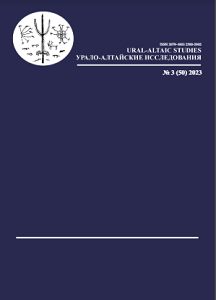О тибетской графеме bya в ойратском "ясном письме"
Tibetan syllable bya in Oirat Clear Script
Author(s): Saglara V. MirzaevaSubject(s): Language studies, Historical Linguistics, Sociolinguistics
Published by: Институт языкознания Российской академии наук
Keywords: Old Kalmyk; “Clear Script”; todo biciq; Jaya Paṇḍita Nam-mkha′ rgya-mtsho; dictionaries; galig letters; Tibetan;
Summary/Abstract: Oirat (Old Kalmyk) “Clear Script” (todo biciq) created by Jaya Paṇḍita Nam-mkha′ rgya-mtsho (1599-1662) in the first half of the 17th century includes basic 25 Oirat letters and additional transcriptional galig letters aimed for spelling of Sanskrit and Tibetan lexemes. Some of these galig letters, namely ᡚ, following the shape of Tibetan syllable (bya), was regarded as belongning to basic todo biciq alphabet to the beginning of 20th century, according to materials of bilingual dictionaries and primer books for Kalmyk children belonging to this period. Meanwhile, in modern Oirat studies there is still no standardized variant of transliteration of this graphic symbol. The paper aims to describe usage of grapheme ᡚ, which we transliterate as ǯ, in lexicographic and didactic materials concerning to Old Kalmyk, to analyze its characteristics in the context of the grapho-phonetic system of Old Kalmyk and also to point out the problem of the necessity to accept some unified variant of transliteration of the sign.. The study is based on materials of “Anonymous Russian-Kalmyk dictionary of the 18th century”, Kalmyk-Russian dictionaries by N. Badmaev (1899) and A. M. Pozdneev (1911), primers for Kalmyk children by K. I. Kostenkov (1871) and L. Narmaev and N. Ochirov (1915). Results. The materials show that galig sign ǯ functions as an allograph of the grapheme ǰ and denotes a voiced affricative sound [дж]. The dictionaries analyzed show diachronic changes in its spelling also when the basic for todo biciq script principle of following the rules of Tibetan orthography (namely when the vowel a is included in the syllable) was broken, and the vowel a began to be written as a separate “tooth”. Moreover, A. M. Pozdneev dictionary and the “Primer of Kalmyk” by L. Narmaev and N. Ochirov show that by the period under consideration (end of 19th - beginning of 20th cent.), graphic symbols ǰ and ǯ as allographs of the sound [дж] were disctibuted in the position of free variation, i. e. they could replace each other.
Journal: Урало-алтайские исследования
- Issue Year: 2023
- Issue No: 03 (50)
- Page Range: 42-55
- Page Count: 14
- Language: Russian

